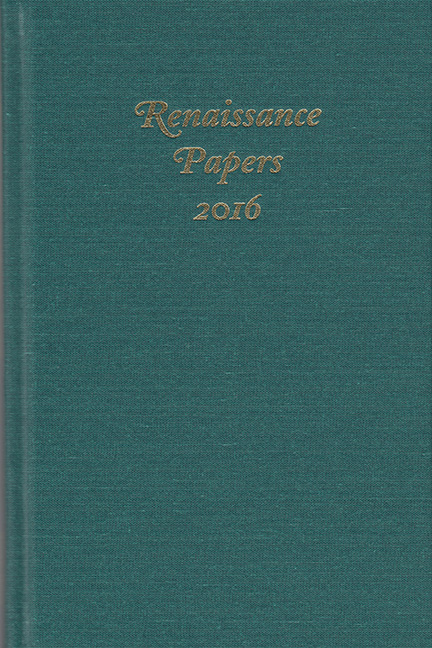Book contents
- Frontmatter
- Contents
- Renaissance Papers
- Beyond Recognition: Mutilation, Marginalia, and the Vicissitudes of Reading
- Velázquez as Reader and the Pictor Doctus in Early Modern Spanish Art
- “Out of this silence yet I picked a welcome”: The Audience in A Midsummer Night's Dream
- Uncommon Justice: The Secret Knowledge and Sagacious Judgment of Old Escalus
- Boundaries in a Globalized World: Shakespeare's Antony and Cleopatra
- Imitation, Innovation, and Imperium: The Grammar School Education of Lear's Daughters
- Violent Brothers, Deadly Antifeminism, and Social Suicide in The Revenger's Tragedy and The Duchess of Malfi
- Canon Fodder: Notes on Don Quijote
Violent Brothers, Deadly Antifeminism, and Social Suicide in The Revenger's Tragedy and The Duchess of Malfi
Published online by Cambridge University Press: 23 August 2019
- Frontmatter
- Contents
- Renaissance Papers
- Beyond Recognition: Mutilation, Marginalia, and the Vicissitudes of Reading
- Velázquez as Reader and the Pictor Doctus in Early Modern Spanish Art
- “Out of this silence yet I picked a welcome”: The Audience in A Midsummer Night's Dream
- Uncommon Justice: The Secret Knowledge and Sagacious Judgment of Old Escalus
- Boundaries in a Globalized World: Shakespeare's Antony and Cleopatra
- Imitation, Innovation, and Imperium: The Grammar School Education of Lear's Daughters
- Violent Brothers, Deadly Antifeminism, and Social Suicide in The Revenger's Tragedy and The Duchess of Malfi
- Canon Fodder: Notes on Don Quijote
Summary
PERFORMED roughly seven years apart, during a period that saw a hierarchically ordered culture undergoing intensely felt alterations, The Revenger's Tragedy (c. 1606) and The Duchess of Malfi (c. 1613) would be hard pressed to place a more pessimistic construction on the relations between the social strata of the societies they dramatize. As early as 1938, L. G. Salingar, focusing on shifts in economic paradigms, argued that The Revenger's Tragedy revealed its author's loathing of nothing less than “the disintegration of a whole social order.” Almost fifty years later, Frank Whigham, focusing on the defensive posture of the aristocracy, made a related but more specific point about The Duchess of Malfi: the play represents “a status-group withdrawal from responsibility to the larger social body.” Clearly a murderous class antagonism lies at the heart of both plays, one that cuts in contrasting ways. In The Revenger's Tragedy, Thomas Middleton portrays the lower-status Vindice as he seeks to protect his family's honor against a predatory aristocracy, wreaking revenge in the most horrific manner that his considerable wit can bring about. In The Duchess of Malfi, John Webster portrays male members of the aristocracy, brothers Ferdinand and the Cardinal, who go to vicious lengths in order to protect their family's purity from the corrupting infiltration of their social inferiors. A search for the mechanisms of class-based violence locates easily the sister as the vulnerable site in both plays. Less obvious, but more crucial to both Middleton's and Webster's diagnosis of this violence, is their relational construction of identity, found most clearly in the relation between brother and sister. This principle works in both plays, first to set the machine in motion and then to define the destruction that follows as suicidal in kind.
Although the plays differ with regard to which class sees itself as subject to the corrupting influence of the other, in both, the sister is portrayed as an extension of the brother, who must guard this shared identity against invasions by another class. In both plays, the brothers' defense of the family, understood to have a communal identity, entails violence aimed not only at the male members of the interloping class, but also at the female members of their own family. Thus they are shown to attack the very means by which they hold their identities.
- Type
- Chapter
- Information
- Renaissance Papers 2016 , pp. 91 - 102Publisher: Boydell & BrewerPrint publication year: 2017



